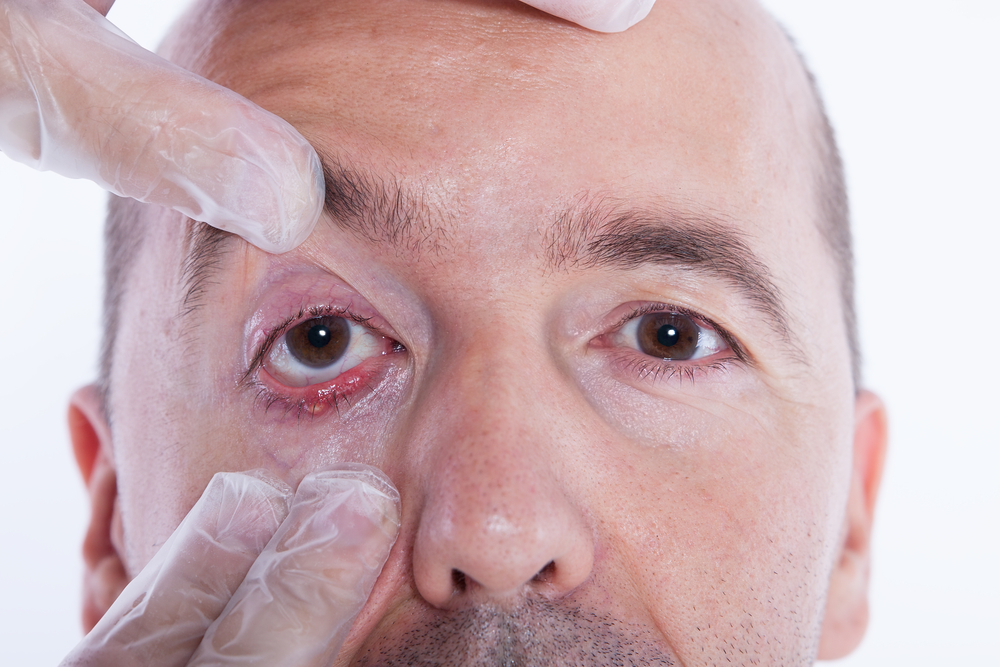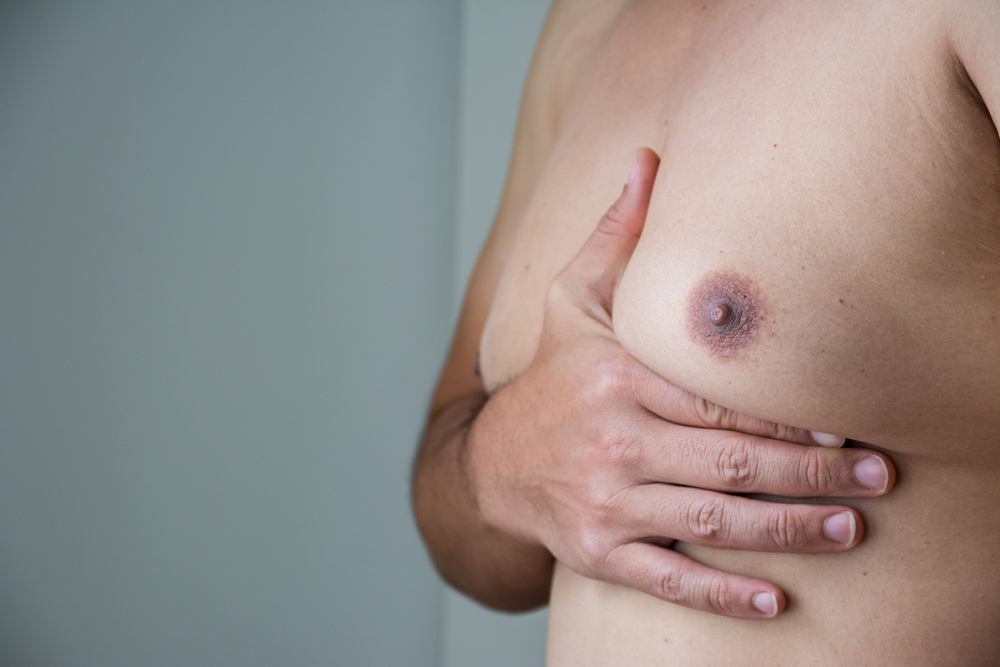- Dermatochalasis is one of several conditions associated with droopy or saggy eyelids.
- Typically a result of aging, it can also be an acquired or congenital condition.
- Blepharoplasty surgery to treat dermatochalasis can be very effective, with little risk and downtime.
- Eyelid ptosis and other related conditions are often corrected during the same procedure.
What Is Dermatochalasis?
Dermatochalasis refers to drooping, loose skin in the upper (most common) and lower eyelid. It is one of several conditions associated with baggy eyelids, in addition to:
- Eyelid ptosis (drooping of the actual eyelid)
- Brow ptosis (drooping of the eyebrow)
- Blepharochalasis (a rare condition with episodic eyelid inflammation)
Dermatochalasis can be congenital (present at birth) but is more commonly a natural result of the aging process. People usually notice droopy eyelids in their 40s—and it gradually worsens as time goes on—but it can also occur in people as young as their 20s, due to genetics.
Even mild to moderate excess eyelid skin can lead to a sad, tired-looking appearance. An excessive amount of eyelid skin can also cause the eyelids to droop in front of the pupils of the eye, obstructing vision.
As facial plastic surgeon Dr. Lisa Ishii, an Executive Committee Board Member for the American Academy of Facial Plastic and Reconstructive Surgery (AAFPRS) notes, some women also complain that eye makeup becomes trapped in the skinfold. They then struggle with mascara because the skin hangs over the eyelashes.
Fortunately, surgery to correct dermatochalasis can be very effective, with few risks and little downtime. The American Academy of Ophthalmology reviewed 13 studies on upper eyelid ptosis and blepharoplasty surgery, stating that blepharoplasty surgery for dermatochalasis provides “significant improvement in vision, peripheral vision, and quality of life activities.”
“Dermatochalasis is so easy to treat and the results can make such a nice difference,” says New York City-based Dr. Stephen Warren, a board-certified plastic surgeon with expertise in adult reconstructive and aesthetic plastic surgery. “I don’t know if there are any ‘fun’ surgeries for a patient, but blepharoplasty would come close because it is a quick, simple, safe procedure, with little pain, a short recovery, and it produces an immediate improvement in the appearance.”
How Dermatochalasis Differs from Ptosis
Dermatochalasis is quite common and can occur in isolation (without ptosis), according to Dr. William H. Truswell, a board-certified facial plastic surgeon based in Easthampton, MA who currently serves as president of the American Academy of Facial Plastic and Reconstructive surgery (AAFPRS). Nearly everyone will develop dermatochalasis to some degree as they grow older. It can also be exacerbated by too much sun exposure and tobacco use.
On the other hand, ptosis refers to the drooping of the upper eyelid itself (as opposed to the skin of the upper eyelid) and is caused by loosening, weakening or injury to the muscle that raises and lowers the lids.
“More specifically, ptosis refers to a specific condition where the margin of the upper eyelid hangs lower than normal over the iris of the eye,” says Dr. Ishii. “To distinguish between the two, one can move the extra skin fold away from the lid margin and make sure that the lid margin is not hanging lower than it should,” she explains.
Dermatochalasis and ptosis frequently go hand in hand, and can often be treated at the same time. However, before moving forward with treatment, the surgeon must conduct a thorough evaluation to determine whether the symptoms reported by the patient are a result of dermatochalasis, ptosis, a third condition, or a combination of these conditions. It is very important to pinpoint the cause, as each of these conditions is treated differently.
A Third Consideration: Brow Position
Many patients present with droopy eyebrows (brow ptosis) in addition to, or in isolation from dermatochalasis and/or eyelid ptosis. Therefore, a third factor your surgeon will take into consideration when conducting an exam is eyebrow position.
In men, the ideal position of the eyebrow is usually at the bony rim above the eye; for women it is above the rim, particularly on the outside of the brow. “As time advances, women’s brows tend to droop too,” notes Dr. Truswell. “This can push excess upper lid skin lower.” Make sure to mention brow position to your surgeon as this factor is sometimes overlooked, depending on the surgeon’s specialty.
According to Dr. Warren, this is particularly the case when excess skin and/or droopy eyelids are significant enough to make the patient contract the frontalis (forehead) muscle, because this disguises the brow droopiness.
“When this situation occurs and the redundant [excess] skin is excised and/or eyelid ptosis corrected, the brow ptosis will ‘appear’ postoperatively,” he explains. “This occurs because the patient no longer needs the frontalis contraction to open the eyes — as the frontalis relaxes, the brow will drop.”
How Is Dermatochalasis Corrected?
Dermatochalasis is corrected by removing the excess skin—and usually some fat—through an eye lift (upper eyelid blepharoplasty) procedure.
“Sometimes a strip of the underlying orbicularis oculi muscle is removed as well, to better contour the lid,” says Truswell. (This is not to be confused with the levator muscle that raises and lowers the eyelid.) In addition, if there is orbital fat bulging near the nose, this will be reduced to aid contouring.
“I close [the] incision with a very fine suture that will dissolve in five or six days,” says Dr. Truswell. “The operation is easily done with local anesthesia, with or without sedation. Bruising may occur. This is usually from the injection of the local anesthetic, not the surgery. The operation is pain-free. The lid will feel stiff for a few days and this can be relieved with cold compresses. Complications are very rare, but as with everything in surgery, experience affects outcomes.”
Combination Procedures: Dermatochalasis, Eyelid Ptosis, and Brow Ptosis
If eyelid ptosis and/or brow position are also an issue, they will be corrected as well—during the same procedure or at a later date. This will depend on the unique circumstances of the patient, and on the surgeon’s individual approach.
For example, Truswell performs eyelid ptosis repair either when the eyelid droops so low that it covers part of the pupil, blocks the superior visual field and interferes with vision, or when the visual field is not blocked but the patient wishes the lid height were higher and/or both lids were even. Addressing these concerns involves shortening the muscle.
A brow lift or forehead lift can be performed to alleviate drooping of the brow and of the upper eyelid skin that is caused by the drooping brow. Truswell often performs this together with blepharoplasty, at least in certain cases.
“If a brow lift is to be done with blepharoplasty, the brow procedure is done first,” he says. “This allows a very accurate assessment of how much lid skin needs to be removed for that patient.”
But some surgeons rarely perform an upper lid blepharoplasty and brow lift simultaneously. As Dr. Benjamin Caughlin, a board-certified facial plastic surgeon in Oakbrook Terrace, IL explains, “I rarely do a brow lift and an upper lid blepharoplasty at the same time because if you were to over tighten that upper eyelid skin, then it can lead to malfunction and not being able to close that lid properly, which can then lead to corneal ulcers or other vision issues. Typically we perform these procedures—a brow lift and a blepharoplasty—in a stepwise fashion.”
Additional Considerations
If you do have dermatochalasis, eyelid surgery may work wonders, as it can address not only cosmetic but functional issues.
“Essentially, dermatochalasis surgery nowadays is considered a cosmetic procedure, but there is a significant functional aspect to it,” says Dr. Caughlin. “Patients report that their eyelids feel lighter, that they feel more awake and putting makeup on or applying mascara to this area is much easier and much more pleasurable.”
However, don’t assume that you can self-diagnose your situation without consulting a qualified surgeon.
“Patients often think they need eyelid surgery when the problem is in reality, a low brow,” states Dr. Truswell. “So, as in all of medicine, a diagnosis and patient education is highly important.”
Dr. Warren concurs. While he would not recommend a brow lift or eyelid ptosis corrections for small degrees of drooping, he says removing too much skin when brow lift or ptosis repair was indicated can have negative effects. Therefore, like Dr. Truswell, he emphasizes how important it is that the surgeon conducts a physical examination to assess the brow, upper eyelid skin, and upper eyelid margin together, and then discuss the findings with the patient in order to make an informed treatment decision.
All of this serves to highlight the uniqueness of each patient’s situation. “It’s quite complicated anatomy and I recommend making sure that people see somebody who specializes in this type of surgery,” sums up Dr. Caughlin.
How Much Does Dermatochalasis Surgery Cost?
Costs are not available specifically for dermatochalasis repair. However, the average cost of eyelid surgery is about $3,000, according to the latest statistics available from the American Society of Plastic Surgeons (ASPS). ASPS has determined the average cost of a brow lift is $3,400.
Note that these costs do not include operating room facility fees, anesthesia fees, or other related expenses. The cost of surgery can also vary markedly depending on the surgeon’s experience and geographic location.
Your best bet is to choose a board-certified plastic surgeon, oculoplastic surgeon, or facial plastic surgeon with expertise in this area.
For those who require a blepharoplasty because the droopiness of your eyelids impede your vision, you should know that it is possible your insurance may cover the cost. Contact your insurance provider to learn the details.









